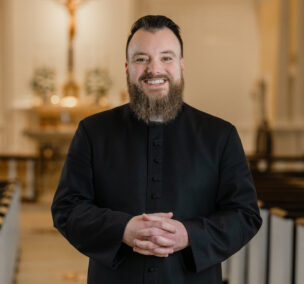Dear Brothers and Sisters in Christ,
Because my everyday wardrobe is mistaken for a Halloween costume almost every year, I rarely give much thought to the day itself. This year, though, I could not help but notice the appearance of spider webs and various inflatable goblins on lawns as early as October 1st. With early Halloween decorating come inevitable questions about what we as Catholics ought to do with this particular day. Is it a demonic evening? Are we opening ourselves to spiritual attacks? Is it pagan? Is it Catholic?
To begin, we can give a cursory (perhaps overly cursory) glance at the origins of this holiday. The Celtic peoples marked the end of summer and the coming of winter as a day they believed the ghosts of their dead would roam. Those spirits, they believed, could wreak havoc on their crops and cause a variety of problems. As such, it became a day when druids sought to divine the future and offered animal sacrifices to their deities. Later, when the Roman Empire came to the British Isles, the Romans brought with them a tradition that coincided on the calendar, a day honoring their dead. On a natural level, this makes a great deal of sense: with the end of the harvest season and the beginning of a season in which very little will grow, it is logical that the thoughts of people turn to death. By the time Christian missionaries arrived, the Catholic feasts of All Saints and All Souls were being celebrated on November 1 and 2, respectively. Some may suggest that the Church was replacing a pagan celebration with a Christian one. I believe a more nuanced description is needed: the Catholic faith, recognizing what was good in the culture (a sense of our continuing spiritual connection with our deceased, a recognition that we ought to pray for the dead) interpreted that goodness in a Catholic context (the saints intercede for us, the name of Jesus has power over the darkness of sin and death, God defeats the evil spirits that roam over the world), and rejected what was incompatible with the Catholic faith (the offering of sacrifices to pagan deities, the superstition – which literally means “false religious belief” – that guided many of the seasonal practices mentioned above). Over time, various customs of dressing as a saint or angel to mark the feast and to honor the holy souls developed and replaced the animal sacrifices and the dressing in the pelts of recently sacrificed creatures. As the holiday has developed in America, we can see a mix of approaches, with some retaining the use of saint costumes, others fascinated by the spooky and scary, and still others attracted to a neo-pagan fascination with the occult.
Next, we might examine the good and the bad of present-day observances of Halloween in our area. On the positive side, we see children having fun dressing up in costumes, pretending to be superheroes, movie characters, dinosaurs, and the like. They are able to exercise their creativity and play. Neighborhoods come together to provide kids with a fun and safe night each year. In the main, the choice of costumes are not motivated by a desire to glorify the demonic, and while some superstitions (black cats, etc) might creep into minds, much of it passes as quickly as the Halloween episode of your favorite TV show, and then is gone. On the negative side, we must acknowledge that occult practices, even Satanism, are very much alive in our world, and those who engage in these activities highlight Halloween as the day of days in their calendar. Demonic activity is a reality with which we Catholics must contend. Sometimes on or around Halloween, things that are profoundly related to the demonic, such as tarot cards, palm reading, and Ouija boards, are presented to us as harmless fun. They are not. They are open doors to unknown spiritual realities, and in fact are often identified by exorcists as the root cause of the spiritual oppression or possession suffered by some people. Even costumes or decorations can point to darker spiritual realities, play close to the border of the occult, or simply encourage sinful behavior and attitudes. Contrary to the lives of the saints which encourage us in the path of virtue, many costumes encourage hedonism, selfishness, and objectification. Think, for example, of the now-ubiquitous prefix “sexy” before so many costumes, which not only denigrates the profession supposedly represented, but also offends against the dignity of and objectifies the person wearing the outfit.
With all this in mind, how might we Catholics engage in and influence a culture that is very enthusiastic for Halloween? First, I suggest sticking to the Catholic engagement with the day: it is the eve of the great solemnity of All Saints, when we honor those heroes of the faith who have given us examples of Gospel virtue to follow. Use the saints as the inspiration for your costumes – if you want something more gory or spooky, use the martyr saints as your inspiration. Don’t be afraid to tell people what you’re dressed as – I guarantee there are very few trick-or-treating saints roaming the streets of Fairfield on any given Halloween! Firmly and forever reject costumes of devils and witches, or any costume that seems to glorify sin. If you don’t want to go for saint costumes, be creative, use puns, use movie, TV, or superhero characters – have fun. Just stay away from the unnecessarily violent, gory, and unvirtuous. Second, remember that for Catholics, the cemetery is not a place of fear but of peaceful anticipation of the glory of the Resurrection. We can and should pray for our dead, reverence their memories, and invoke the saints to help us in this life. Halloween really is a preparation day for our Catholic celebration of All Saints and All Souls days. Third, skip the party games (or parties) that make light of the occult or pooh-pooh the reality of spiritual warfare: those things are (spiritually) deadly serious and not to be trifled with. Fourth, avoid horror movies (I confess, it’s a genre I’ve never understood or enjoyed, so maybe I’m speaking more from personal preference than from pastoral wisdom). Fifth, getting free candy is always fun. Remember, it’s free. There is no requirement to be scary, to be evil, or to be undead. The candy is still free. So get the free candy while being funny, virtuous, and alive! Finally, keep in mind the unseen spiritual realities that are moving at all times, not only on Halloween. As we do every day after Mass, offer the Prayer to St. Michael the Archangel for protection from the evil spirits that prowl the world. Pray the Rosary as often as possible (and as a family whenever possible). Receive the Sacrament of Reconciliation/confession with regularity and keep your soul firmly in the safe harbor of the Sacred Heart of Jesus. Let Halloween be a day when your faith in Jesus Christ informs the culture in which you live.
Peace,
Fr. Sam


